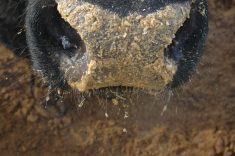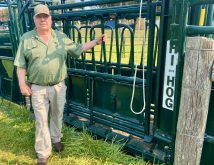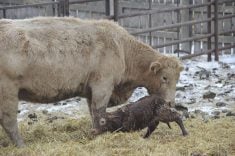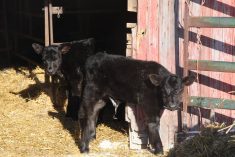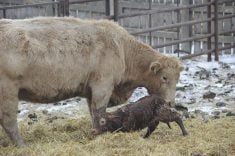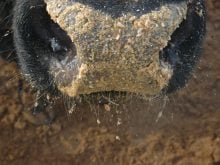A cow or heifer that refuses its own calf often doesn’t have the hormone it needs to be motherly or hasn’t released its milk
Many ranchers have a trick or two up their sleeves to convince a cow or heifer to accept a calf that’s not its own.
“It’s always about putting a calf onto a cow that doesn’t really want it. Sometimes that can be her own calf, but typically it’s trying to place an orphan or twin calf onto a mother cow that has milk,” said Dr. Joe Stookey, professor emeritus at the University of Saskatchewan’s Western College of Veterinary Medicine.
“That is somewhat of the trick because sometimes they’re not receptive,” said Stookey, who is also an applied animal behaviourist and Speckle Park producer.
Read Also

Beef cattle more prone to trace mineral deficiencies
The trace mineral status of our cows and calves is a significant challenge for western Canadian producers and veterinarians.
“Look for another candidate in your herd that needs a calf. She might take that calf and be better than a cow that’s reluctant to claim it.”
Stookey said a cow or heifer that doesn’t want its own calf can be traced to the hormone profile. Like a cow or heifer that wasn’t bred because it wasn’t cycling, maternal behaviour is hormonally controlled.
“I’d really encourage people to take a step back and realize that a cow that doesn’t want her calf, there’s a good chance she’s got the wrong hormonal profile,” said Stookey.
“She is not receptive because she doesn’t have the hormone that she needs to be motherly.”
Another reason for rejection is as simple as non-release of milk.
“Getting that calf to nurse for the first time can jumpstart the whole process because she’ll have an oxytocin release by the milk letdown, and that’s a good thing,” said Stookey.
“Oxytocin is that important hormone that facilitates the bonding response.”
However, he advises against giving the mother a shot of oxytocin.
“You can’t give a shot of oxytocin and expect it to turn on maternal behaviour. It won’t do that even though it’s the hormone responsible because you’re not getting it into the brain where it needs to be.
“That’s really where you need it. If the calf starts to suckle and she has a milk let down from the stimulation of the udder, that started happening in the right place in the brain and oxytocin will help facilitate maternal behaviour,” he said.
If a calf is born dead, do not let the cow lick or smell it because she will imprint.
The dead calf should be quickly removed and replaced with a live orphan or twin, which is common practice among producers, Stookey said.
“You don’t have to force a calf on a cow that doesn’t want it. There might be other candidates in your herd. One of them is a cow that you just pulled the dead calf from. She’s a great candidate.”
The foster calf’s legs could be tied to prevent it from running to the udder. Smear the afterbirth or fetal fluid of the cow over the calf and wait for the mother to clean it.
“She will think it’s hers. Once she’s doing a good job of licking the calf, you can cut the string and let the calf jump up and go to the udder. That’s a good trick,” Stookey said.
“Cows don’t let every calf in the pen up to their udder. They have to check them and make sure they’re theirs.
“So that’s what’s going to happen if you put a calf with a cow that doesn’t know who her calf is yet and runs right to the udder. That’s out of sequence. She has to identify it as her own.”
In the event of a pulled calf or caesarean, putting birth fluids on the cow’s muzzle helps get her interested in the calf.
“Some of those cows, you don’t have to do anything. They’re so maternal that all you have to do is put the cow and the calf together and she’ll claim it. Those grafts go pretty quick,” Stookey said.
Sprinkling a few handfuls of grain over the calf’s back attracts the cow and can help with bonding.
Skinning a dead calf is also a popular technique used to fool the mother into thinking the foster calf is hers. Only the skin over the back, along with the tail, is needed.
Another technique is putting the cow in the head gate and tying a leg back so she cannot kick the calf as it tries to nurse.
“You do that two, three times a day for a couple days, most cows will take the calf because that milk let down will hopefully start maternal instincts,” he said.
With twins, many cows will be content with just one calf and reject a second.
Stookey recommends putting them all together in a separate pen for a few days to make sure both calves are cared for.
“They will learn to stick together and they will learn to nurse at the same time,” he said.
However, if adequate milk is not available for both, a calf can be bottle fed until a foster opportunity arises.
It’s not uncommon for producers to have high-producing nurse cows available for this purpose. They usually have some dairy blood and can feed several calves without a problem.
In this situation, however, the dairy cow’s diet should be supplemented to maintain milk production.
“You have to make sure that she is allowing all the calves to nurse. I would pen her separately with the calves for about a week and give her supplemental nutrition,” he said.




